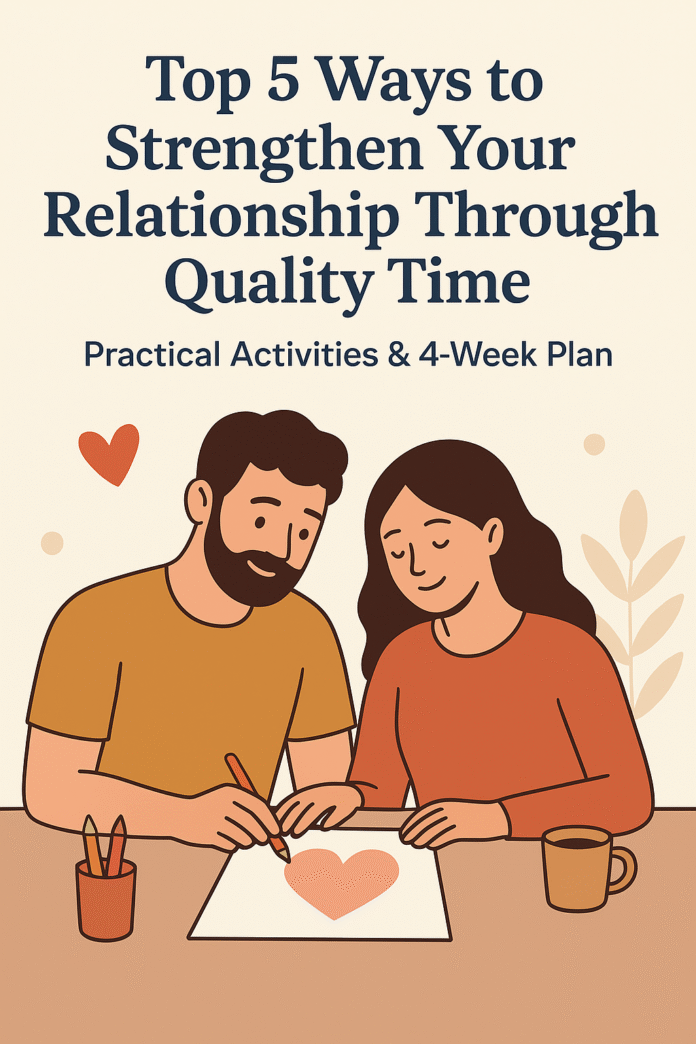Strong relationships don’t happen by accident — they’re built, intentionally, one shared moment at a time. This article dives into the top five activities you can use to strengthen your relationship through quality time, explains why they work, and gives you clear, beginner-friendly steps, progressions, safety tips, and a ready-to-run 4-week starter plan. If you want to improve connection, reduce boredom, and make your together-time feel meaningful again, read on. (You’ll see the primary topic — quality time — and practical guidance within the first 100 words.)
Quick note: If your relationship is experiencing serious issues (patterned abuse, frequent violence, or long-standing trauma), consider seeking support from a qualified mental health or legal professional for personalized help.
Key takeaways
- Quality time = measurable relationship fuel. Doing focused, shared activities increases closeness, reduces boredom, and predicts better relationship satisfaction.
- Variety matters. Novel, playful, and supportive activities each strengthen different parts of your bond — rotate them.
- Small, consistent investments win. Intentional weekly routines (even an extra few hours a week) beat rare grand gestures.
- You don’t need big budgets. Most powerful activities can be low-cost and adapted to hearts, homes, or small windows of time.
- Track progress simply. Use frequency, mood before/after, and short check-ins as your metrics.
Why quality time matters (brief framing)
Time spent together is not just clock minutes — it’s the context in which partners exchange support, laugh, learn, and remember. When couples purposefully spend time together doing shared activities, they report higher feelings of closeness, better communication, and more satisfaction. Also, freeing up time by reducing daily stressors and spending those freed minutes intentionally has been shown to lead to happier relationships. This article converts that research-backed idea into five practical activity types you can use today.
Activity 1: Shared Novel Experiences (adventures, mini-adventures, new classes)
What it is and core benefits
Shared novel experiences are activities you and your partner haven’t done together before or that push you out of routine (a weekend hike in a new park, a pottery class, a short road trip). These experiences create shared novelty and mild arousal, which (when positive) renew excitement, reduce boredom, and can increase attraction and long-term satisfaction. Novel activities also create fresh memories and stories that become relationship glue.
Core benefits
- Rekindles excitement and curiosity about one another.
- Builds shared, unique memories.
- Reduces relationship boredom; increases desire and vitality.
- Teaches problem-solving and teamwork in new settings.
Requirements / prerequisites and low-cost alternatives
Typical needs
- Time: a few hours to a weekend.
- A little planning: tickets, gear, transport.
- Openness to trying something unfamiliar.
Low-cost alternatives
- Do a “novelty walk”: take a new route in your neighborhood and treat it like a micro-adventure.
- Swap skills nights: each partner teaches the other a hobby they’ve never tried.
- Try a free local event, community class, or library workshop.
Step-by-step instructions (beginner-friendly)
- Pick the level of novelty. Choose something slightly outside both your comfort zones — not dangerous, just new.
- Schedule it. Put it on the calendar like an appointment (avoid the “someday” trap).
- Agree on goals. Is the aim laughter, skill-building, or relaxation? Align expectations.
- Minimize distractions. Phones off or in airplane mode for at least part of the activity.
- Debrief. Afterward spend 10–15 minutes sharing the highlight and what surprised you.
Beginner modifications and progressions
- Simplify: Start with 30–60 minute novel tasks (try a new coffee shop or a 1-hour pottery intro).
- Progress: Move to overnight trips, multi-day retreats, or a stretch goal class (rock-climbing, scuba).
- Mix novelty with comfort: combine a new activity with a favorite meal to balance excitement and safety.
Recommended frequency / duration / metrics
- Frequency: Aim for one novel micro-date every 1–2 weeks and one bigger novelty (day trip or class) monthly.
- Duration: Micro-novelties: 30–90 minutes. Bigger trips: half day to weekend.
- Metrics: After each activity, rate mood/connection on a 1–10 scale and track whether boredom decreased over the week.
Safety, caveats, and common mistakes to avoid
- Don’t choose novelty that triggers real fear (extreme sports) unless both consent and prepare.
- Avoid planning things one partner secretly dislikes; surprise is good, coercion is not.
- Be mindful of budgets: novelty shouldn’t create lasting financial stress.
Mini sample plan (2–3 steps)
- This weekend: Walk an unfamiliar neighborhood and pick a small café to try.
- Next week: Each partner lists two “novel ideas” and you pick one for a Saturday micro-date.
Activity 2: Regular Date Night (out or at-home rituals)
What it is and core benefits
A regular date night is a scheduled time when partners focus on each other — no multitasking, no household chores. Date nights create ritual, foster anticipation, and provide space to reconnect intentionally. Over time, consistent ritual time stabilizes positive interaction patterns and signaling of priority.
Core benefits
- Creates ongoing intentional connection in busy routines.
- Provides a dedicated space for conversation, play, and romance.
- Prevents relationship drift by preserving a “we” rhythm.
Requirements / prerequisites and low-cost alternatives
Typical needs
- A recurring calendar slot (weekly or biweekly).
- Agreement on budget and format.
Low-cost/home alternatives
- At-home candlelit dinner twice a month.
- A board game night or movie-paired-with-a-theme snack evening.
Step-by-step instructions
- Agree on cadence. Choose weekly, biweekly, or twice monthly based on schedules.
- Rotate planning. Alternate who plans the night to keep variety and shared investment.
- Set boundaries. Decide on phone rules and end times to keep it focused.
- Include a checkpoint. Use the last 10 minutes to ask two honest, curious questions (see sample prompts later).
Beginner modifications and progressions
- Simplify: Start with 30–45 minute “mini dates” after kids are in bed.
- Progress: Build to a monthly “big date” (dinner + experience) or quarterly overnight.
- Spice up: Theme dates (country night, nostalgia night, skills swap) to maintain freshness.
Recommended frequency / duration / metrics
- Frequency: Once a week is ideal for many couples; if that’s unrealistic, twice a month for starters.
- Duration: 60–120 minutes for meaningful interaction; mini-dates 20–45 minutes.
- Metrics: Track adherence (how many dates per month), mood pre/post, and a short “connection score” (1–10).
Safety, caveats, and common mistakes
- Don’t let date night become another chore. If it becomes stressful, pause and renegotiate format.
- Avoid using date night only for heavy problem-solving — keep at least half the time positive and light.
Mini sample plan (2–3 steps)
- This Friday: 60-minute at-home date — make a two-course meal together and spend 20 minutes sharing recent wins.
- Next scheduled date: Outdoor picnic with no phones for the first 45 minutes.
Activity 3: Shared Projects or Hobbies (cooking, fitness, DIY, creative projects)
What it is and core benefits
Shared projects are collaborative efforts that take more than one session: a garden, a home improvement project, training for a 5K, or learning to cook from a new cuisine. These activities combine everyday cooperation, joint problem-solving, and shared progress — powerful for building partnership identity.
Core benefits
- Builds teamwork and mutual competence.
- Allows partners to co-create something tangible.
- Encourages steady interaction and small wins.
Requirements / prerequisites and low-cost alternatives
Typical needs
- Some tools or materials for many projects (though many hobbies need minimal gear).
- Scheduling several sessions.
Low-cost alternatives
- Upcycle a thrifted item together rather than buy new furniture.
- Follow free online tutorials for cooking or fitness.
Step-by-step instructions
- Choose a project you both care about. Ask: is this fun, meaningful, or useful?
- Break it into micro-tasks. Assign small, clear roles so both contribute.
- Schedule recurring work sessions. Even 45 minutes weekly moves things forward.
- Celebrate milestones. Take a photo, make a small ritual when you complete a step.
Beginner modifications and progressions
- Simplify: Start with a short 2–3 week craft or a single recipe night each week.
- Progress: Move to multi-week classes, joint business ideas, or an annual big project (garden, renovation).
- Skill swapping: Teach each other a skill in a 20-minute session once a week.
Recommended frequency / duration / metrics
- Frequency: Weekly sessions (45–90 minutes) are effective.
- Duration: Depends on project; aim for consistency rather than long epic sessions.
- Metrics: Track progress by completed milestones and subjective teamwork ratings.
Safety, caveats, and common mistakes
- Avoid letting power imbalances (one partner always in charge) lead to resentment.
- Be realistic about skill levels; mistakes are part of learning—avoid perfection pressure.
Mini sample plan (2–3 steps)
- Week 1: Choose the project and list five micro-tasks.
- Week 2: Complete task 1 together in a 60-minute session and take a progress photo.
Activity 4: Intentional Communication Sessions (state-of-the-union, gratitude, check-ins)
What it is and core benefits
Intentional communication sessions are structured conversations with a clear goal: update each other, problem-solve, express appreciation, or repair a small hurt. Done regularly and kindly, they prevent small issues from becoming big ones and make partners feel heard and supported.
Core benefits
- Reduces misunderstandings and hidden resentments.
- Builds psychological safety and mutual support.
- Improves empathy, active listening, and conflict management.
Requirements / prerequisites and low-cost alternatives
Typical needs
- A quiet, private time slot.
- A neutral structure or script to follow.
Low-cost alternatives
- Use a simple 10-minute “check-in and appreciation” format nightly.
- Use a shared notebook for written check-ins if talking feels hard.
Step-by-step instructions
- Pick a structure. Example: 10-minute mini-check-in or 60-minute weekly “state-of-the-union.”
- Set rules: no interrupting, no blaming; use phrases like “I feel…” rather than “You always…”.
- Start with appreciation: Begin by naming one thing you valued about the partner that week.
- One concern, one solution: If raising an issue, limit to one topic and brainstorm solutions together.
- Close with a commitment: Agree on a small next step to try before the next session.
Beginner modifications and progressions
- Simplify: Start with 5-minute nightly check-ins where each person shares one high and one low.
- Progress: Move to a weekly 30–60 minute meeting that includes goals, affection, and problem-solving.
- If conversation stalls: Use a timer (2 minutes each) or switch to written prompts.
Recommended frequency / duration / metrics
- Frequency: Nightly mini-check-ins (5–10 minutes) + weekly longer check-in (30–60 minutes).
- Duration: Mini: 5–10 minutes. Weekly: 30–60 minutes.
- Metrics: Track number of check-ins kept, percent of items resolved, and perceived understanding scores.
Safety, caveats, and common mistakes
- Avoid turning check-ins into criticism sessions. Use curiosity and curiosity-based questions.
- Don’t use these sessions to ambush your partner or raise long-standing grievances without preparation.
- When emotions run high, pause and agree to return after cooling down.
Mini sample plan (2–3 steps)
- Every evening: Two-minute check-in — one “high” and one “need” share.
- Weekly: 40-minute meeting focusing on logistics, a small problem to solve, and an appreciation exercise.
Activity 5: Play, Laughter, and Low-stakes Fun (games, comedy, inside jokes)
What it is and core benefits
Playful activities are any interaction centered on fun — board games, improv, watching a funny show, inside jokes, or playful teasing done kindly. Shared laughter synchronizes mood and fosters closeness. Play also signals friendship within a romantic partnership and makes conflict recovery easier.
Core benefits
- Boosts positive affect and reduces stress.
- Reinforces the couple’s friendship and shared history.
- Makes tough conversations easier to reframe.
Requirements / prerequisites and low-cost alternatives
Typical needs
- A sense of permission to be silly.
- Minimal supplies for many games (cards, a board game, or a smartphone).
Low-cost alternatives
- Play 10-minute “micro-games” (20 Questions, silly storytelling) after dinner.
- Watch short comedy clips together and pick the best one each night.
Step-by-step instructions
- Pick an activity you both enjoy. If you’re unsure, alternate choices each session.
- Set the tone. Agree that the goal is fun, not competition or dominance.
- Lean into shared inside jokes. Create a ritual to use an inside joke to defuse tension.
- Debrief with gratitude. End with a quick “that was fun because…” line to reinforce positive memory.
Beginner modifications and progressions
- Simplify: Start with 10–15 minute nightly comedy clips or a quick card game.
- Progress: Try cooperative games or creative improv classes for a deeper shared challenge.
- If one partner is reserved: Use low-pressure playful formats (watching funny videos) to ease in.
Recommended frequency / duration / metrics
- Frequency: Aim for daily micro-play moments (5–15 minutes) and a dedicated 60-90 minute playful night once a week.
- Duration: Micro: 5–15 minutes. Play night: 60–120 minutes.
- Metrics: Count micro-play moments per week; rate laughter frequency and perceived joy.
Safety, caveats, and common mistakes
- Avoid sarcasm or humor that targets sensitive insecurities.
- Don’t weaponize play to avoid real issues. Play should coexist with honest communication.
Mini sample plan (2–3 steps)
- Tonight (10 min): Watch three short comedy clips and vote on the funniest.
- This weekend: Try a cooperative board game and celebrate a shared win.
Practical add-ons
Quick-start checklist (warm-up before you begin)
- Schedule a time and put it on both calendars.
- Agree on phone rules for the activity window.
- Choose one of the five activity buckets (novelty, date night, project, check-in, play).
- Prepare any minimal materials ahead of time.
- Decide on a short post-activity debrief (5–10 minutes).
Warm-up exercises (for connection before deeper activities)
- Two-minute eye contact: Sit quietly and maintain soft eye contact for two minutes.
- The gratitude starter: Each partner names one small thing they appreciated today.
- The three-question jog: Ask: 1) What surprised you this week? 2) What energized you? 3) One small request for me?
Troubleshooting / common pitfalls and fixes
- Problem: “We’re too busy.” Fix: Start with 10-minute micro-dates and build.
- Problem: One partner doesn’t engage. Fix: Ask what they’d enjoy and negotiate formats; rotate planning.
- Problem: Dates feel forced or boring. Fix: Introduce novelty or change the environment.
- Problem: Check-ins become arguments. Fix: Use a structured script and a timer; allow for a cooling-off period.
- Problem: Financial stress from activities. Fix: Choose low-cost alternatives and set a monthly “connection budget.”
How to measure progress (simple, actionable metrics)
Use three easy trackers:
- Frequency adherence: Count how many scheduled quality-time sessions you actually did.
- Connection score: Each partner rates daily/weekly connection on a 1–10 scale.
- Mood delta: Before/after mood rating for each activity (quick 1–5 scale).
After four weeks, compare averages: ideally frequency increases, connection score improves, and mood delta is positive.
4-week starter plan: Simple roadmap to build the habit
This plan blends all five activity types to create momentum and variety. Each week includes one novel micro-activity, a date night, a project checkpoint, a communication session, and daily micro-play.
Week 1 — Foundation
- Mon–Sun: Daily micro-play (5–10 minutes; watch short clip, play a joke).
- Wednesday: 10-minute phone-off check-in after dinner.
- Saturday: 60-minute at-home date — cook a new recipe together.
- Sunday: 30-minute planning session: choose a shared project and list three first steps.
Week 2 — Add novelty
- Daily: Micro-play continues.
- Tuesday: 15-minute appreciation check-in.
- Friday: Micro-novelty: take a new neighborhood walk and pick a café.
- Saturday: Project 1 — do the first micro-task (45–60 minutes).
Week 3 — Deepen communication
- Daily: Keep micro-play.
- Wednesday: 30-minute intentional communication session (gratitude, one area to improve, one solution).
- Saturday: Larger novelty: day trip or outdoor excursion (half day).
- Sunday: Review project progress; celebrate a small win.
Week 4 — Consolidate and reflect
- Daily: Keep micro-play; small rituals.
- Friday: 60–90 minute special date night (alternate planner).
- Saturday: Continue project; capture before/after photos.
- Sunday: 60-minute reflection: review metrics (frequency, connection scores), note what to continue, and set next month’s plan.
Safety, boundaries, and when to get outside help
Quality-time strategies strengthen most relationships but are not a substitute for professional help when there is ongoing abuse, addiction, or untreated mental health issues. If any interaction is physically dangerous, manipulative, or consistently harmful, prioritize safety planning and consult a qualified professional. For structured guidance on conflict patterns or complex problems, working with a couples therapist can provide tools tailored to your relationship.
Frequently Asked Questions (8–12)
- How much time per week is enough to improve a relationship?
Aim for intentional time rather than a strict number, but many couples notice benefits when they add a focused few hours weekly. A modest, consistent routine (several micro-sessions plus one longer date) often outperforms occasional big efforts. - What if my partner doesn’t want to try these activities?
Start with tiny, low-pressure steps that require minimal commitment (10-minute micro-play or a short walk). Invite curiosity rather than demand. Ask what would feel meaningful to them and co-create a plan. - Can these activities help after a rough patch?
Yes. Shared positive experiences rebuild goodwill and offer neutral ground to reconnect. Pair positive activities with structured communication for best results. - Do quality-time activities work for long-distance relationships?
Absolutely. Adapt: schedule synchronous activities (watch a show together, cook the same recipe while on video) and prioritize meaningful check-ins. - How do I keep things fresh without planning too much?
Rotate the five activity types: novelty, date nights, shared projects, intentional communication, and playful moments. Use surprise sparingly; shared planning increases buy-in. - Is it normal for one partner to enjoy novelty more than the other?
Yes. Balance is key. Alternate who chooses the activity and adapt intensity. For introverted partners, choose lower-sensory novelty or at-home experiments. - What if we argue during a scheduled session?
Pause and use the agreed safety rule: step away, breathe, and return after cooling off or move the topic to a later time with a plan to revisit calmly. - How can we measure whether these activities actually improve our relationship?
Use simple metrics: weekly session adherence, pre/post activity mood ratings, and a monthly connection score. Track trends rather than obsess over single data points. - Are expensive dates better than low-cost rituals?
Not necessarily. Consistency and emotional presence matter far more than price. Many research-backed benefits come from shared attention, not spending. - Can these activities reduce relationship boredom?
Yes. Novel and playful activities are especially effective at reducing boredom and increasing positive emotions. - How do we fit this into busy parental schedules?
Use micro-dates (10–20 minutes), include kids in some activities occasionally, and guard a weekly couple-only ritual (even if short). - When should we consider couples therapy instead?
If patterns of conflict are entrenched, if one partner is unsafe, or if progress stalls despite consistent effort, a trained couple therapist can provide tailored interventions.
Final motivating conclusion
Quality time is the simplest relationship “investment” with outsized returns: consistency, creativity, and care transform ordinary minutes into durable connection. Pick one activity, schedule it this week, and treat it as something you both deserve — not an optional luxury. Try the 4-week starter plan above, track one simple metric, and watch small changes compound into stronger closeness.
CTA: Choose your first activity now and put it on the calendar — your relationship will thank you.
References
- Buying (quality) time predicts relationship satisfaction — Journal of Personality and Social Psychology (Abstract page). April 2025. https://pubmed.ncbi.nlm.nih.gov/40257910/
- Time Spent Together in Intimate Relationships: Implications for Relationship Functioning — Personality and Social Psychology Bulletin / PubMed Central. 2021 (article available in PMC). https://www.ncbi.nlm.nih.gov/pmc/articles/PMC8320759/
- Putting Laughter in Context: Shared Laughter as Behavioral Indicator of Relationship Well-Being — Personal Relationships (Full text in PubMed Central). December 1, 2015. https://pmc.ncbi.nlm.nih.gov/articles/PMC4779443/
- Novel activities boost relationship satisfaction through felt security — Journal of Experimental Social Psychology (article abstract and records). 2019 (research and PDFs available). https://www.sciencedirect.com/science/article/abs/pii/S0022103119308091
- Couples’ shared participation in novel and arousing activities and experienced relationship quality — Journal of Personality and Social Psychology. February 2000. https://pubmed.ncbi.nlm.nih.gov/10707334/
- 6 Hours a Week to a Better Relationship (practical framework) — The Gottman Institute (blog post). (Practical recommendation and framework for weekly intentional time). https://www.gottman.com/blog/6-hours-a-week-to-a-better-relationship/
- Couple Vacations: Linking Joint Vacation Experiences of Romantic Couples to Satisfaction with Relationship Life — Leisure/Travel research article. 2023. https://www.tandfonline.com/doi/abs/10.1080/01490400.2023.2174216
- Travel Strengthens Relationships and Ignites Romance (survey report, PDF) — U.S. Travel Association (survey findings on travel and relationships). 2013 (report). https://dl.icdst.org/pdfs/files3/8736e5824840b421ee38560916693e6d.pdf




































